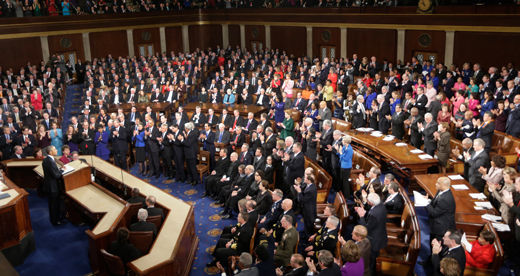
WASHINGTON – President Obama says his $4 trillion federal budget proposal for the year starting October 1 would, if enacted, enhance retirement security and improve worker protections for millions of people.
His budget also proposes a $478 billion 6-year plan to start rebuilding the nation’s highways, airports and railroads and fund its subways and buses. But he wants to pay for that by a one-time hike in taxes on business overseas profits, a scheme that drew scorn from the Republican-run 114th Congress.
Obama’s budget is a starting point in the annual White House-Congress tug-of-war over government and its priorities – a tug-of-war that’s more bitter now that the GOP totally runs Congress, and more urgent by the fact that if they don’t agree, sequestration, the GOP-mandated budget cuts of several years ago, resumes on October 1.
Obama denounced sequestration and said it should end.
Two union leaders lauded parts of Obama’s budget blueprint. AFT President Randi Weingarten praised Obama’s proposed education spending hikes, though she was silent about his parallel charter schools scheme. And Roseann DeMoro of National Nurses United had endorsed the increased taxes on business profits when the administration leaked them earlier.
But AFGE President J. David Cox, whose union represents federal workers, said Obama’s proposed 1.3 percent pay raise would not cover the rising cost of groceries. His union and its allies back a 3.8 percent raise authored by Congress’ minority Democrats.
Politically, a typical Republican reaction came from Rep. John Kline, R-Minn., the right wing chairman of the House Education and the Workforce Committee. “The president’s priorities continue to be more spending, more taxes, and more government,” Kline said. “Middle-class families are being squeezed, and the president wants to double-down on the same failed policies of the last six years,” he further alleged.
“Government can’t do it all, but it can help level the playing field for working families. That’s what the president’s budget aims to do,” Weingarten said. “By targeting investments in child care and paid sick leave, enabling more students to go to community college and helping battle America’s worn infrastructure, it gives more families a pathway to the middle class.
“With half of public school students living in poverty and more than 30 states funding public education at pre-recession levels, the president’s proposed $1 billion increase” in money to help the lowest-income students “will be a huge help. It will give all kids equal resources, including the computers, lower class sizes, and nurses and counselors they need, even when their communities can’t afford to give it to them,” she added.
Cox said Obama proposed a “substandard pay raise” for the nation’s 2.1 million federal workers, union and non-union. The budget “fails to honor the nation’s commitment to our dedicated public sector employees,” he added.
After a 3-year freeze on federal pay and two weeks of no pay following the prior sequester, “Let’s be real – a 1.3 percent pay raise will be eaten up by higher costs for groceries, health care and other essentials,” he added. “Like other middle-class workers, federal employees need a meaningful pay raise to make up for years of stagnant wages, and unfortunately the president’s proposal falls short.”
Other details in Obama’s budget plan include:
“$1.9 billion for the Department of Labor’s (DOL) worker protection agencies, putting them on sound footing to meet their responsibilities to defend the health, safety, wages, working conditions, and retirement security of American workers.” That includes job safety and health, wage and hour enforcement and the administration’s campaign against employer misclassification of workers as “independent contractors,” who are not covered by Social Security, Medicare or workers’ comp – and who lack the right to organize.
“The administration is also pursuing a combination of executive and legislative actions to strengthen these laws and their enforcement, so workers can earn wages that will allow them to sustain their families, be protected from discrimination, return home safely at the end of a day’s work, and retire with dignity,” the budget says.
Family sustaining wages includes Obama’s proposal to “raise the minimum wage so hard-working Americans can earn enough to support their families and make ends meet,” the budget says. But other than citing his own executive order to federal contractors imposing a $10.10 hourly minimum, Obama didn’t propose a figure. The $7.25 federal minimum hasn’t risen in almost a decade and the minimum for tipped workers, $2.13, hasn’t risen in 22 years.
Proposes “almost $990 million for the Occupational and Mine Safety and Health Administrations to make sure workers are protected from health and safety hazards on the job.” Obama wants more money “to enhance safety and security at chemical facilities and improve response procedures” to major accidents at them. “The budget also bolsters OSHA’s ability to enforce the more than 20 whistle-blower laws that protect workers from discrimination and retaliation when they report unsafe and unscrupulous practices,” Obama says.
More money for enforcement against job safety and wage and hour lawbreakers – and higher fines. But Obama did not say how high he wants the fines to go. OSHA’s fines, set almost 40 years ago, are so low that unions repeatedly point out they do not deter employers from endangering workers. He’d leave the recommendations up to the non-partisan Government Accountability Office and the Administrative Conference of the United States.
A $500 million increase in workforce training money to improve and expand training and job hunt services. That’s almost half of the $1.3 billion hike Obama wants – from $11.9 billion this year to $13.2 billion in the year starting October 1 – for all Labor Department “discretionary” (not mandated) programs.
“This investment would reach the one-third of unemployment insurance beneficiaries who are most likely to run out of benefits before getting reemployed, all returning veterans who receive unemployment benefits, and other displaced workers who come into American Job Centers for help getting back to work and onto a new career path. Evidence suggests that these types of services are a cost-effective intervention that get workers back into jobs faster, and help employers to fill their in-demand jobs.”
Obama’s budget also urges lawmakers to renew Trade Adjustment Assistance, a special program to give extended aid to workers who lose jobs due to unfairly subsidized foreign imports. Presidents have often used TAA as a bargaining chip, however, to get lawmakers to support job-losing “free trade” pacts – and Obama is pushing those, too.
Extending some retirement security to part-timers. One proposal would automatically enroll workers whose employers don’t provide retirement plans into Individual Retirement Accounts though payroll deductions. And Obama wants Congress to pass a law saying part-timers who worked at least 500 hours yearly for the same firm for at least three years would become “eligible to participate” in the employer’s retirement plan. But the employers would not have to match the part-timers’ contributions.
Photo: President Obama gives his State of the Union address before a joint session of Congress in Washington, Jan. 20. (AP Photo/Pablo Martinez Monsivais)












Comments